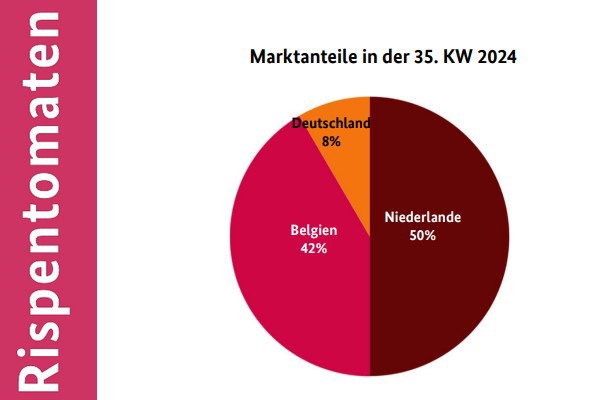Belgian and Dutch offerings have unquestionably dominated the German market in week 35. Italian and Spanish items were also available for cherry tomatoes. In the round tomato segment, Polish lots in Munich and Berlin rounded off the market. German products were available in the cherry tomato, vine tomato and round tomato segments. Overall, availability expanded noticeably, with deliveries from the Netherlands in particular increasing significantly. According to the BLE, demand was not always able to keep pace with this, meaning that retailers were sometimes forced to offer discounts if they wanted to avoid large surpluses. However, purchase-related price increases were also frequently observed. Prices also rose as a result of improved storage facilities. In Berlin, domestic products lost importance.
 © BLE
© BLE
Click here for the full market and price report.
Apples
The presence of European batches increased steadily: German Elstar, Holstein Cox, Delbarestivale and Wellant gained in relevance. Gravensteiner and Tenroy were also slightly more common than before. Italian Royal Gala were also increasingly supplied.
Pears
Santa Maria from Turkey and Italy formed the basis of the range. The first Italian Williams Christ joined the range, and the relevance of French Williams Christ also increased. Clapps Liebling and Williams Christ were the main varieties from Germany.
Table grapes
Italian varieties dominated and became even more important. A wide range was available, with light-coloured seedless fruit taking centre stage. Italia gained in relevance, and Crimson Seedless was also encountered somewhat more frequently. Turkish sultanas also played an important role.
Peaches/nectarines
Spanish products predominated, with a few Turkish and French batches rounding off the scene. The supply was limited in line with the season, with Italian offerings already disappearing from the range locally. The favourable weather conditions ensured an appealing demand.
Plums
The campaign slowly but surely drew to a close: Deliveries were apparently somewhat reduced, and late varieties gained in importance. Auerbacher, Fellenberg and Hauszwetschge were more common, while Cacaks Frühe and Cacaks Schöne lost relevance.
Lemons
Spanish Verna had almost completely disappeared from the market, Primofiori of the same origin were only available in very small quantities. Valuations were trending upwards. Prices also rose for competitors from South Africa, Uruguay, and Argentina.
Bananas
Business was relatively uneven: while the supply in Hamburg was adequately matched to the accommodation options and prices remained constant, valuations in Cologne trended downwards for a large part of the range.
Cauliflower
Domestic offerings obviously dominated the scene. Batches from Belgium, the Netherlands, Poland, and Austria made selective appearances. The trades were all fairly quiet. Prices developed unevenly.
Salads
Iceberg lettuce came from Germany, the Netherlands, and Spain. Domestic products in particular were not entirely convincing in Berlin in terms of quality, which is why a wide price range was established. Lettuce came from Germany, Belgium, and the Netherlands.
Cucumbers
The assortment of cucumbers consisted of domestic, Dutch and Belgian offerings. Interest was very favourable. In Berlin, however, large quantities were tied to the food retail trade. In addition, customer access had increased in the capital as a result of a TikTok hype, meaning that supply was rather tight.
Sweet peppers
Dutch deliveries dominated over Polish deliveries. Shipments from Belgium rounded off the picture. Turkish produce in Hamburg was not entirely convincing in terms of quality. In general, prices tended to show an upward trend, although this slowed down subsequent processing in some cases.
Source: BLE
